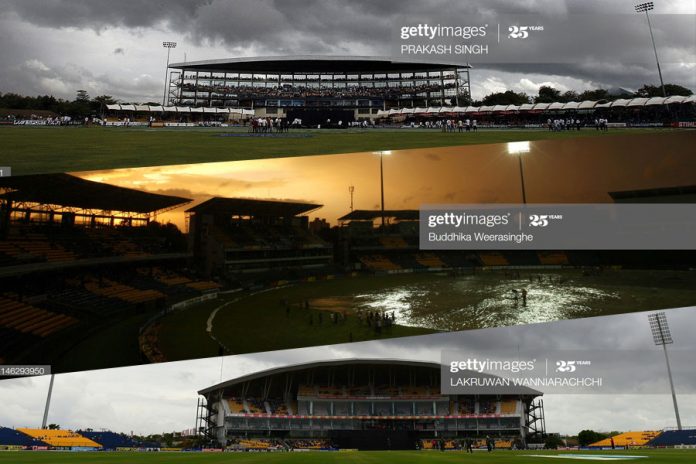In part 1 of International Cricket Grounds in Sri Lanka, we saw some of the historic venues that were instrumental in the growth of Cricket in this country. Now it’s time that we have a look at the newbies, the concrete giants around the Island.
Test venues in Sri Lanka: The Oldies
- Premadasa International Cricket Stadium – The Commercial Capital of Sri Lankan Cricket
When the crowd turn-up to the grounds increased, Sri Lanka needed to crank up its capacity in stadiums. This giant structure was born then. More as a political interest of the former President of Sri Lanka Mr Ranasinghe Premadasa, but still served the purpose. The ground can hold up to 35,000 people.
The stadium was opened in 1986 and the first ODI was played between Pakistan and Sri Lanka. The concrete bowl has since then hosted 9 Tests, 129 ODIs and 36 T20Is. The numbers include an ICC T20 World Cup Final (2012) and an ICC World Cup semi-final (2011). Sri Lanka has had a good track record here in Tests and One-Day cricket. They have 4 Test wins against the 1 loss and 4 draws here. The home team also have recorded 69 wins in the 111 games played at the venue. But, T20Is remain a woe for them at Khettarama. A painful 16 losses against the 4 wins in the shortest form of cricket here for Sri Lanka. That includes the Marlon Samuels heroics in the 2012 T20 World Cup final.
One can never forget the 340 made by the master-blaster here in 1997. Sri Lanka recorded the highest Test score of 925 for 6 in that match. But still, Test cricket at R. Premadasa is a thought that is pretty tough to conquer. The flat wickets make the limited overs games more interesting but leave Test cricket a drag.
Nuwan Kulasekera – Little man with a big heart
It’s always a festival environment at R. Premadasa. So, if you love that atmosphere, anywhere in the ground could be the best place for you. But generally, the upper levels close the sight screens give the best mix of cricket and party at R. Premadasa Stadium.
Galle International Cricket Stadium – Tests at the Shore
33 Tests, 33976 runs, 1067 wickets and cricket in the shade of a UNESCO world heritage site. The Dutch-built racecourse is eventually used to satisfy the Lankan craze. The ground was first used for cricket in the 1890s and officially announced as a cricket stadium in 1927. A turf wicket was laid in 1945 and the first first-class game was held in 1984. Galle became Sri Lanka’s 7th Test venue in 1998 when it hosted New Zealand.
This is Sri Lanka’s most prominent Test venue. Anyone who tours Sri Lanka has to go through the scrutiny of Galle before they taste any rewards in the Isle.
Sri Lanka’s Greatest ODI innings: Poll
Sitting beneath the Galle fort and bordered by the sea on two sides, this is one of the most scenic stadiums in the world. Test cricket is always a joy here in Southern Sri Lanka. Ask the Barmy Army if in doubt.
6 one-dayers have been played here but the lack of stands and the square-turning wicket doesn’t fit the format. Forget T20Is. And why is Test cricket so dear to the venue? Well, 27 out of the 33 Tests have produced results here.
The view at the Galle press box is stunning. If you are lucky enough to get there, there is no better place to watch cricket in Sri Lanka. But generally, people prefer the Galle Fort, at an elevation right behind the bowler’s arm.
Rangiri Dambulla International Cricket Stadium – The rain-proofing.
The main purpose of this stadium is to furnish Sri Lanka with cricket during the monsoons. This is the first and only stadium in the dry zone of the country. To hold justice to the idea, only 3 games out of the 55 One-Dayers played here have ended without a result.
The ground was built on a land that is leased from the Rangiri Dambulla temple. There were several occasions when this ground was left to starve, due to lease contract discrepancies and dodgy floodlights. Since 2016 though, it serves Sri Lanka cricket as a regular One-Day venue.
Warne vs Murali | Who is the King of Spin?
In the ancient town of Dambulla, the ground holds enough beauty about it. It is located right in between the Dambulla Tank and Dambulla Rock. The strong wind across the ground because of the adjoining reservoir, is something that teams playing here plan especially for.
The grass banks on either side are the best place to chill with the breeze blowing hard at you. If you can find a spot a little straight, watching cricket here is a pleasure.
Mahinda Rajapaksha International Cricket Stadium – The Gulliver
This massive stadium was built for the 2011 World Cup held in Sri Lanka. The ground’s rural location and the lack of spectators in games made it a political hot topic right from its birth. Even electricity is hardly accommodated in the location. Games were affected by floodlight failure at the venue a couple of times.
This 100 square meter play area is mostly occupied by wild animals in the thick forests near the ground. It is said that if you are in the stand or the dressing room, the players look tiny on the grounds. That is how huge this ground is. It can hold up to 35000 people and most parts of the sitting area are the grass banks.
In its 9 year existence, the ground has hosted 21 ODIs and 7 T20Is. A pavilion right behind the bowler’s arm is the best position to be in this stadium unless you enjoy trying to find shade more than watching the match.
Pallekele International Cricket Stadium – The Modest Stadium
After putting Asgiriya to rest, Pallekele emerged to satisfy the cricket fans in the hill country. A gorgeous vessel amidst the hills. This was also another project leading up to the 2011 World Cup. The ground has been a regular venue across all 3 formats for Sri Lanka.
When Lord’s waited for Chandimal’s century
It is located at just a half-hour drive from Kandy. Majority of the seating facilities are grass banks here too and similar to Hambantota has a stand adjoining the sightscreen.
Pallekele has hosted 25 ODIs, 7 Tests and 22 T20s in its decade long service to Sri Lankan cricket. At Pallekele you are never just idling at long-leg during a Test match. The lovely sceneries around the ground will keep you company. The weather never takes a toll on the players and the wicket is even and alive. Perfect settings for cricket.
You will be able to get a good view of the game from anywhere in the ground. Because of its pit-like nature, the play feels closer and it’s easy to follow the ball. Pallekele is the new Asgiriya. Cricket plus the backdrop makes it worth the money!


















